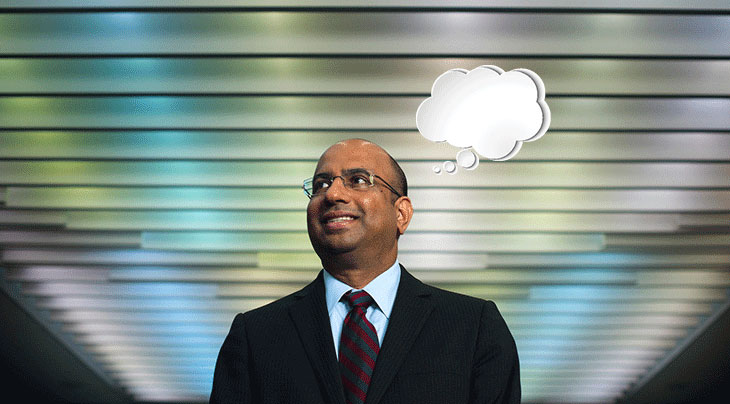We live, learn, and work now in a drastically different world than the one that we inhabited a few short weeks ago. Everything looks uncertain, and the future appears unclear. While it's clear that we need to rely on the essential human qualities of kindness, empathy, gratitude, compassion, and creativity to get us through these difficult times, we still need to make a concerted choice: face each day with fear or look ahead with optimism. I, for one, choose optimism borne out of our historical record. We bat a perfect record when faced with debilitating crises as a civil society, and we have always emerged stronger.
For instance, I'm often asked about my thoughts concerning the implications of the pandemic on higher education. Education is a public good, and because it changes the lives of our students and their families, it positively impacts society. Hence, despite the doom and gloom espoused by pundits about the imminent collapse of higher education, I believe that progressive institutions that focus on building resilience, embracing innovation, and shaping the future through re-imagination will thrive in the post-pandemic future.
The pandemic is likely to accelerate innovations in digital infrastructure and software solutions for students. As mindsets change about the possibilities and potential of virtual education, online learning based on well-planned pedagogical principles will finally come of age. Digital convergence – the seamless integration of the face-to-face and the digital worlds – will become a new reality for all residential higher educational institutions. We need to be prepared for this eventuality, not to mention that this integrated setting is right pedagogically for our students as they prepare for the future of work. Digital convergence will entail a digital-first mindset that approaches any new opportunity with a digital-as-default solution and involves a holistic digital + physical approach for the entire student journey.
Here are some ways I believe digital convergence will impact higher education:
Digital content creation will explode
- Our institutions are already partially “digitally transformed.” For instance, we recruit, admit, and subsequently engage students through institutional websites, chat bots, online collateral, and social media. We also use apps to keep them appraised of campus events and happenings. Students arrive digitally ready with their own devices, and faculty members already utilize digital learning platforms, online fora, and digital textbooks. Additionally, we mine analytical data to make evidence-based decisions and track institutional success, and we offer online degree programs where appropriate. The last bastion for complete digital transformation is large scale digital content creation and systematic integration with face-to-face instruction. The emphasis on social distancing for the foreseeable future will act as an accelerant for large scale digital content creation to be employed in hybrid teaching models, combining face-to-face teaching with online education.
Delivering outstanding student experiences in integrated settings will drive future success
- Digital content creation requires human-centered design to deliver exemplary student engagement. We need to bring best practices from the content creation world (i.e.: 10-minute videos, simulations, and gamified content) as we design engaging modules. It's not about merely porting face-to-face content online; it's about designing around the instructor's strengths and capabilities. Let us also not forget that valuable content can be found everywhere. Want to learn about the lessons from the 1918 pandemic? There are videos on YouTube that can bring you up to speed in an hour. And we should curate cutting-edge content from outside partners to provide real-world relevant perspectives. When we thoughtfully integrate these digital modules into face-to-face settings, the nature of in-class engagement will change so we can deliver outstanding student experiences and drive successful pedagogical outcomes. Of course, digital modules can be bundled in different courses and contexts (undergraduate, graduate, executive education, etc.) to enable large-scale but relevant revenue streams for institutions.
Developing an agile “test-learn-develop” agenda is critical
- Integrating digital content into face-to-face settings will represent a new way of life for most residential institutions, but change in higher education is traditionally difficult and slow. We will need to think and act like a startup by adopting an agile new product development approach that embodies many of the attributes of a startup, such as collaboration across teams, speed, rapid action, critical feedback, and ability to pivot quickly. It's very easy to decipher what works and what doesn't in digital settings, which can be quickly generalized to face-to-face settings. Digital Minimum Viable Products (MVPs) based on clear value propositions for students should be quickly formulated and tested, and the resultant feedback can be used to refine the final products. Where appropriate, we need to be ready to sunset offerings as well.
In summary, the future is not going to be about “business as usual.” It will require us to shift perspectives and think differently. At D'Amore-McKim and Northeastern, we pride ourselves on being entrepreneurial, and we're known for our willingness to adopt innovative approaches. We're ready to heed Dr. Katie Martin's call to “spark curiosity, ignite passion, and unleash genius” in this emerging world of digital convergence.
Raj Echambadi
Dunton Family Dean
D'Amore-McKim School of Business
